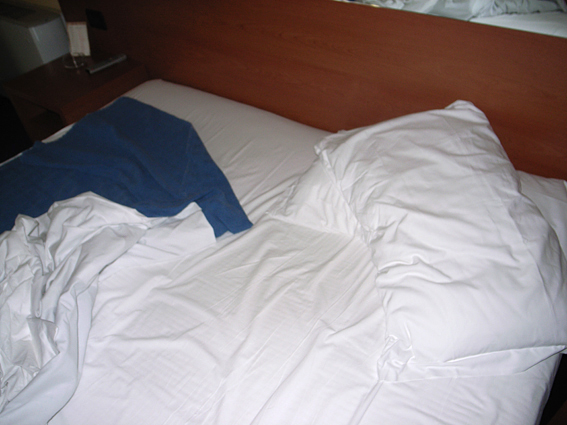
07.25am: Start of Day 2.
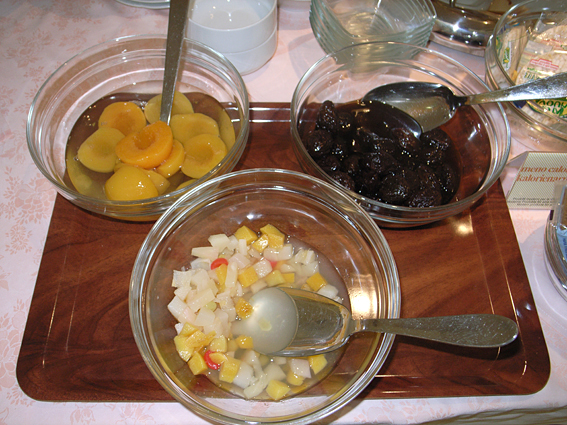
07.45am: Breakfast – where’s the full English?
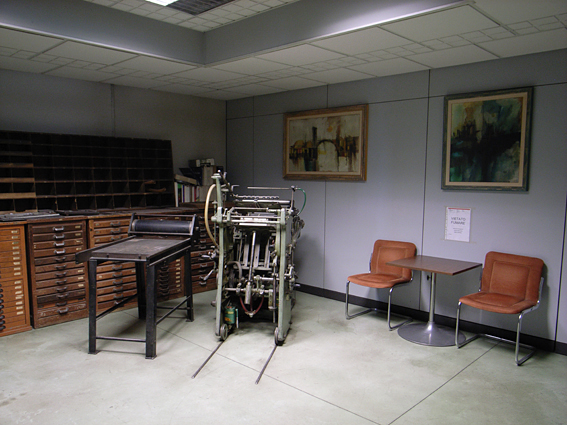
08.30am: To EBS for first official day on press.
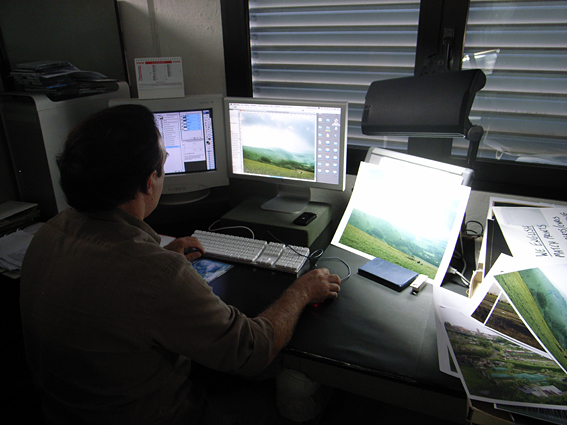
09.00am: In pre-press for some last minute colour corrections.
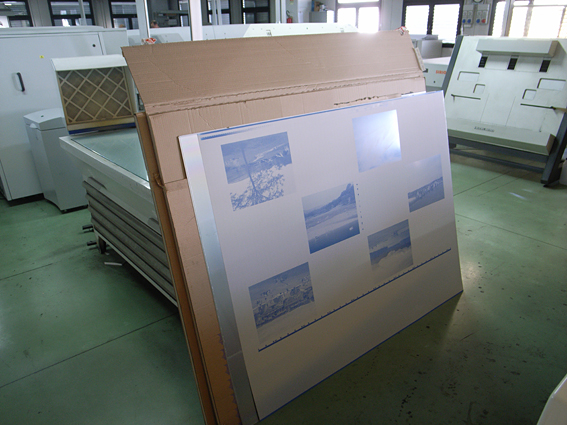
09.15am: The first metal plate ready to go the press (there are six double pages per plate).
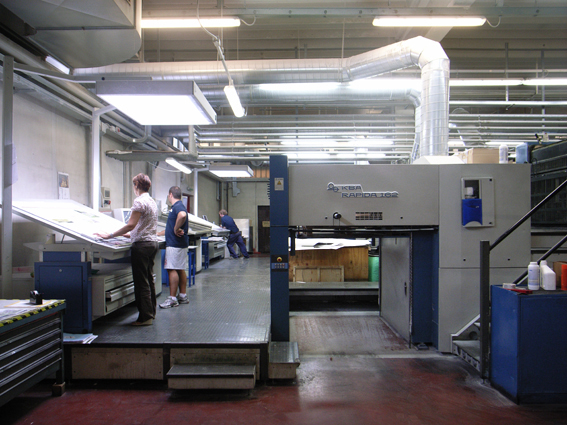
09.50am: The hardware – a German made KBA Rapida 162 five colour press.
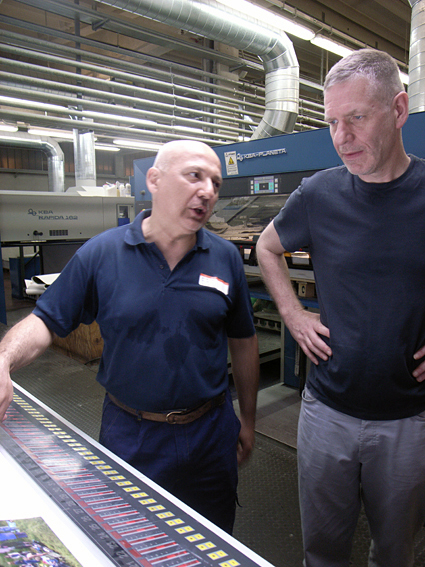
10.10am: We’re introduced to the head printer Daniele aka Kojak.
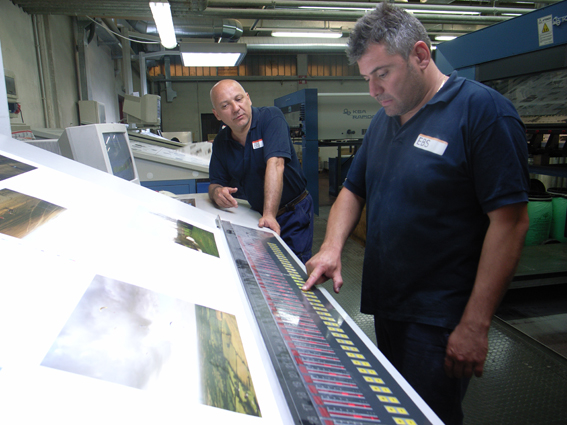
10.30am: The first sheet is prepared – in total we will be printing ten sheets.
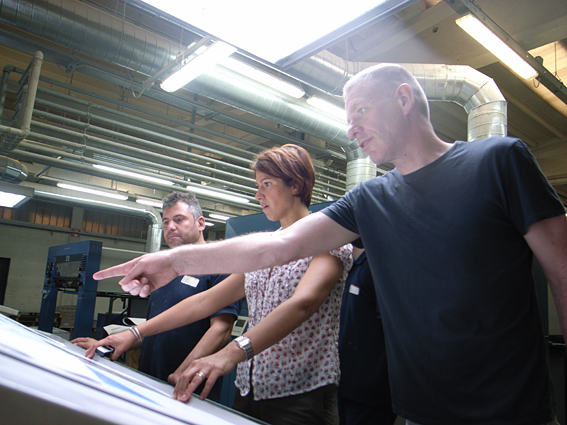
10.30am: Overseeing some colour and contrast adjustments to the first sheet. This is nerve-racking!
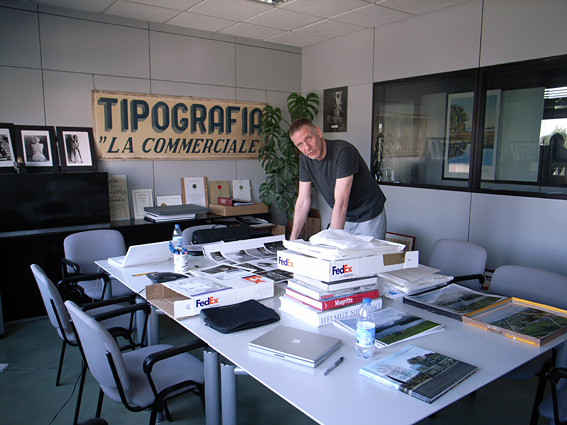
11.10am: Two hours of down time.Chris works on the proofs for his other Autumn publication Georgian Spring – A Magnum Journal.
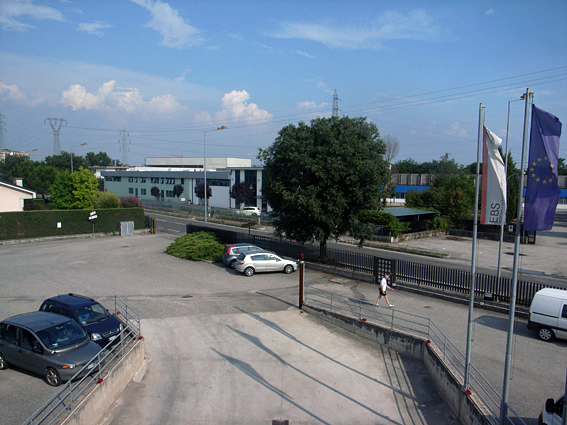
11.50am: The view from our temporary base in the EBS offices.
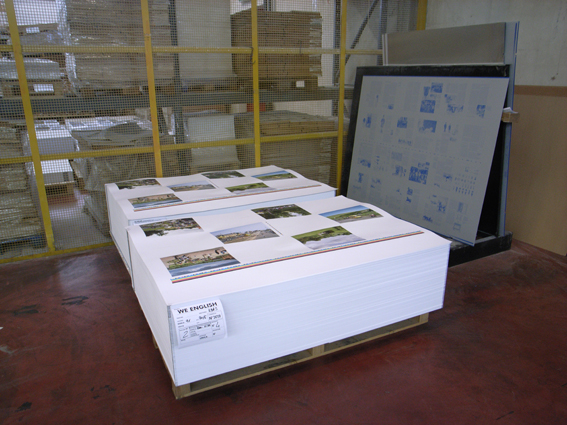
12.10am: The completed first sheet, which will be passed through the press to print on the reverse side.
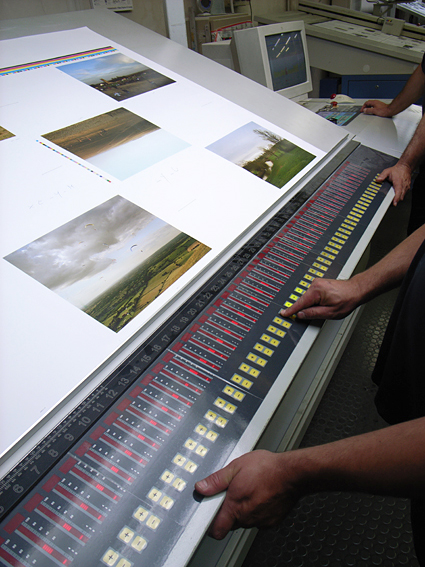
12.20pm: Making adjustments to the contrast of the second sheet.
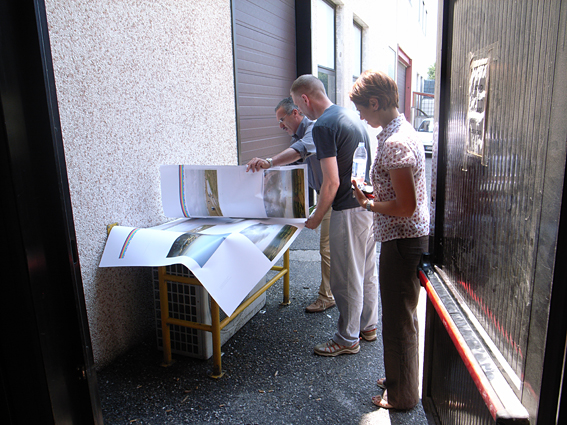
14.15pm: We’ve got an issue with green! We’re finding the colour balance and contrast shifts considerably under different light sources, so we head outside with Franco (the Director of Printing) to check what adjustments are needed.
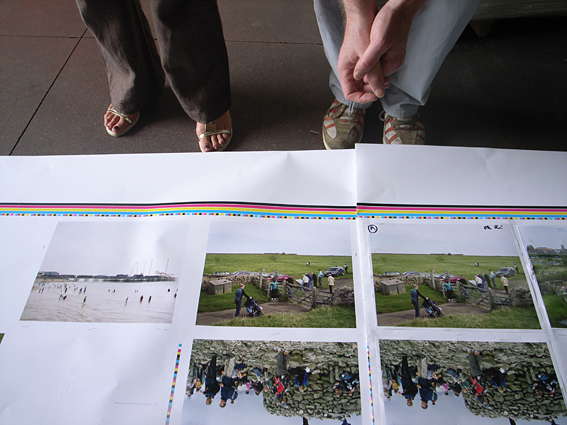
15.45: A new sheet and more discussions, comparing against our digital proofs.
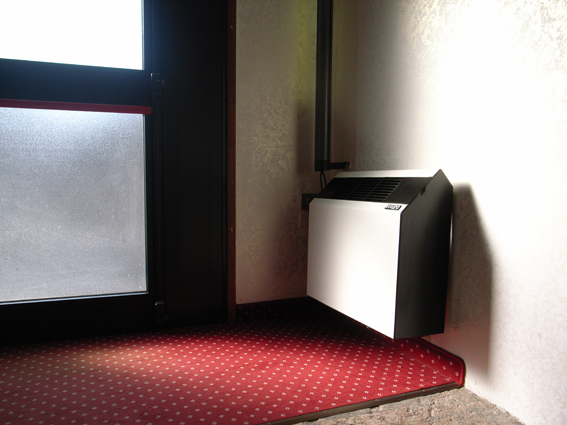
16.35pm: More down time. The temperature outside is 36C so thank goodness for air conditioning!
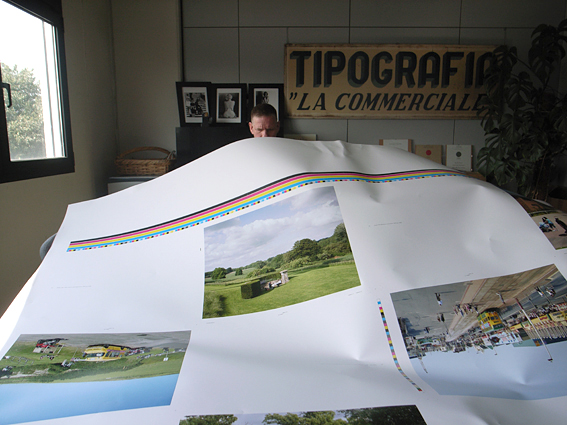
17.00pm: Inspecting the final sheet of the day once the ink has settled and under daylight conditions.
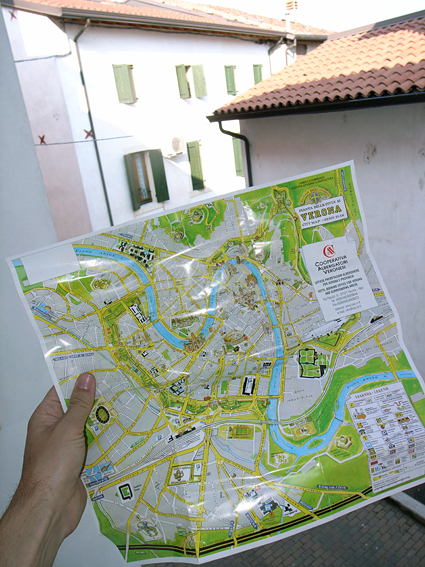
18.00pm: Heading into Verona for dinner.
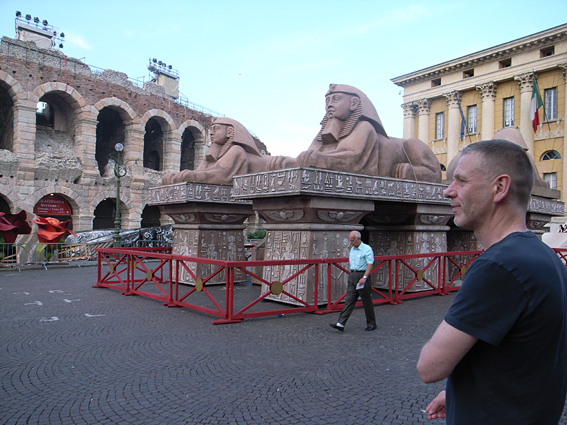
19.30pm: A bit of site seeing – props for Aida currently playing at the Colosseum.
Posted in POST PRODUCTION | 2 Comments »
This morning Chris Boot and I fly to Verona where we’ll spend the next few days on press printing We English.
Inspired by Mr Hetherington’s recent ‘A Week in the life’ post over on his Whats the Jackanory? blog, I’ve decided to keep a daily photo diary of our exploits….

06.30am: Packing the essentials

07.10am: Jemima wishes Daddy well (complete with self-inflicted Chicken-pox!)

12.50pm local time: Arrive Verona after two-hour delay at Gatwick (temperature 34C)
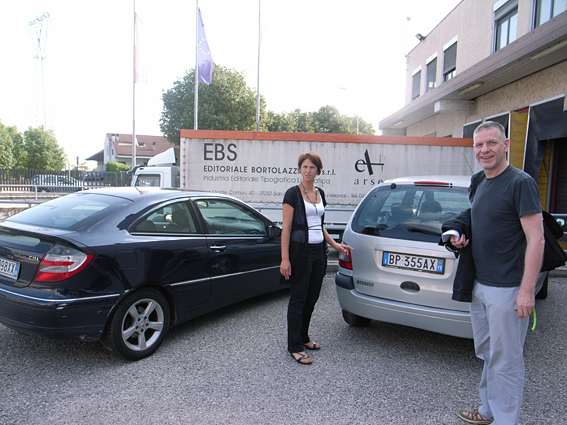
13.10pm: Arrive EBS Printers, our home for the next three days, and meet our host Alessandra

13.30pm: Dump luggage

13.45pm: Chris gets straight down to work
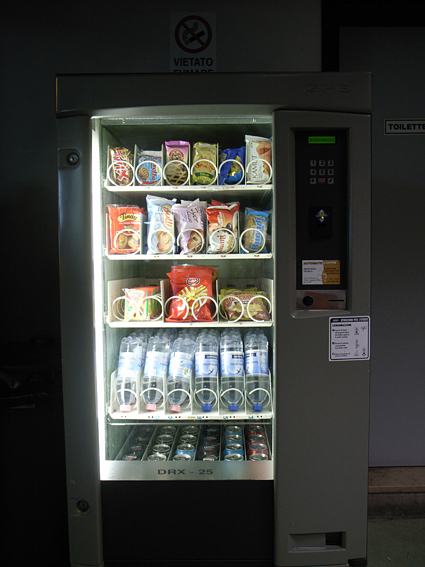
13.50pm: I go to the snack machine

14.20pm: The ozalid ready for approval

15.05pm: Final digital proofs checked and signed off

16:40pm: Digital proofs ordered ready to take on press tomorrow for colour matching
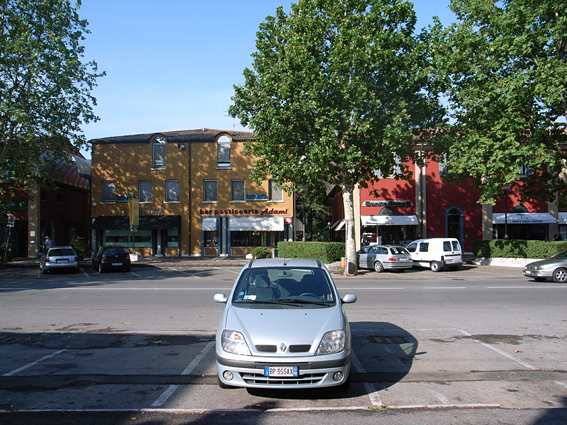
17.05pm: Leave EBS and pick up our wheels for the week

17.35pm: Check-in at Hotel City, Via Madonnina

18.05pm: Chris proposes a flying visit to Lake Garda for the evening

19.35pm: Searching out a secluded spot for a swim (temperature still about 29C)
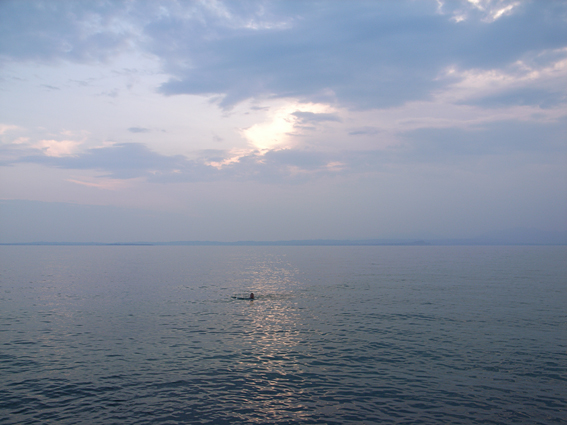
19.55pm: A sunset dip to cool off

21.40pm: A litre of vino rosso and the end of day 1
Posted in POST PRODUCTION | 1 Comment »
“I love processions – as humans, it’s almost part of our DNA to be instinctively attracted to big public events that bring us together. A good procession is in itself a public artwork: part self-portrait and part alternative reality.”
Jeremy Deller
Jeremy Deller is in the news a lot lately promoting his new body of work, Procession, which will take place at the Manchester International Festival on July 5th. With participants drawn from across Greater Manchester, Procession represents what Deller describes as ‘northern social surrealism’, combining social clubs, special interest groups, popular music and invited individuals with traditional processional stalwarts such as Rose Queens and brass bands.
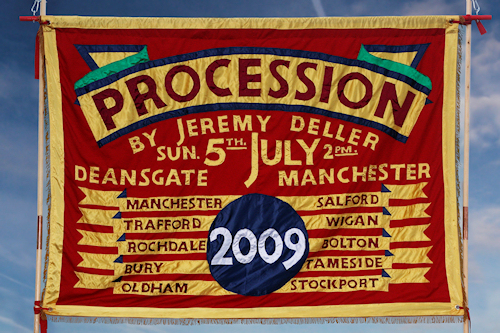
Given his current profile I thought it was about time I did post about this artist and his work.
Deller, was born in London in 1966 and studied art history at the Courtauld Institute of Art. Collaboration and participation are central to Deller’s work. As he explains, “A good collaboration is like going on a long journey without a map, never knowing quite where you will end up.” He acts as curator, producer or director of a broad range of projects, including orchestrated events, films and publications, which draw attention to forms of culture on the fringes of the mainstream or reveal hidden histories. He currently lives and works in London.
He is perhaps best-known for The Battle of Orgreave, ‘a piece of living history’ which was a commissioned by Artangel in 2001. This work brought together veteran miners and members of historical re-enactment societies who restaged the controversial clash between miners and the police during 1984-5. This collaboration resulted in a film, a book and an audio recording, which all ‘function to resurrect the raw emotions from the period and provide a fresh account of events that have been distorted by the media.’
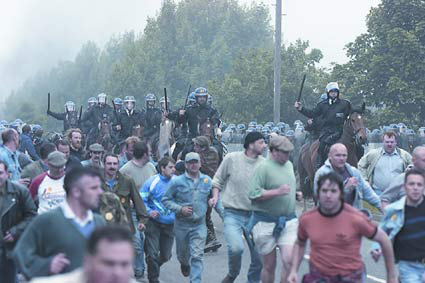
Still from The Battle of Orgreave, Commissioned and produced by Artangel © Jeremy Deller, 2001
Deller won the prestigious Turner prize in 2004, shortlisted for his installation Memory Bucket at ArtPace, San Antonio. The film uses documentary techniques to explore the state of Texas, focusing on two politically charged locations: the site of the Branch Davidian siege in Waco and President Bush’s home town of Crawford. Archive news footage is collaged with interviews, juxtaposing official reports with personal narratives. (You can find details of Deller’s prize winning entry on Tate Britain’s website here).
The project was filmed months after the US and UK invasion of Iraq and documents Deller’s travels in Texas which he talks to a variety of individuals, from staff in George Bush’s local diner in Crawford, to Quaker anti-war protesters. Deller has said “making that film made me realise that it was actually possible to talk to peple almost at random, and ask questions and get responses from them, and that a journey is a very good way to present or make an artwork.”
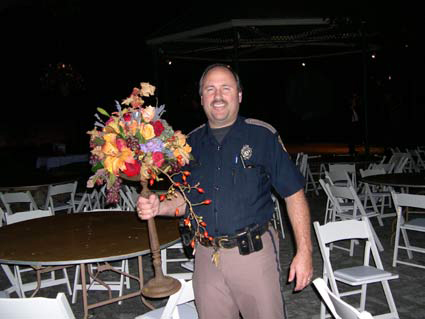
Cop with Flowers, San Antonio, Texas © Jeremy Deller, 2003
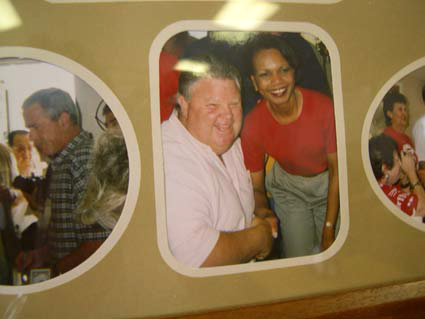
Coffee Station, Crawford, Texas. Still from Memory Bucket © Jeremy Deller, 2003
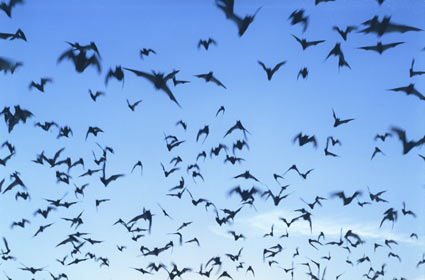
The Bats. Still from Memory Bucket © 2003
Deller has recently completed a new body of work in America, called ‘It is what it is, USA, 2009’. The work stems from a failed application to place the shell of a burnt-out car on the 4th Plinth in Trafalgar Square. The vehicle had been hit by a bomb attack in central Baghdad in which 35 people died. Instead he took the remains of the vehicle on a three-week road trip from New York to Los Angeles in a project co-sponsored by the public art group Creative Time. He was joined by Jonathan Harvey, a US soldier who served in Iraq; an Iraqi artist, Esam Pasha, who worked as a translator for the US army and now lives in the US; a curator from New York; a writer and a road manager. You can read an article by Esam Pasha in this month’s issue of The Art Newspaper here.
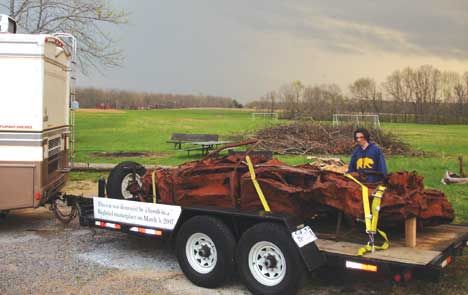
Jeremy Deller on a farm in Summertown, Tennessee for ‘It is what it is, USA, 2009’
Back on home soil, Deller has often explored the cultural and political heritage of Britain and it’s his work ‘Folk Archive’ with fellow artist Alan Kane, that was of most interest to me in connection with We English.
Kane and Deller took seven years to create the Folk Archive, (1998-2005),amassing a huge collection of vernacular artefacts froma cross Britian, from drawings and paintings to costumes and decorations. Among the 250 works are the detritus of political protests, car rallies, crop circles, clowns and office life. There are photos and footage of strange festivals and competitions where life becomes performance art, including the World Gurning Championships, and a festival of insults and horse skulls in South Wales, called Mari Lwyd.
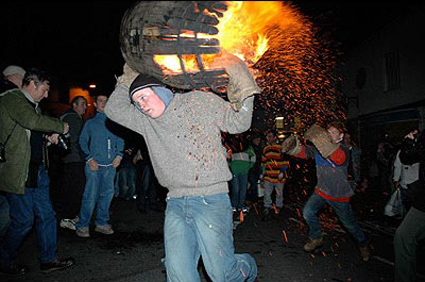
Tar Barrel Rolling, Ottery St. Mary, Devon © 2004
Interviewed by Iain Aitch in The Guardian in 2005, Deller said “We are not looking for the most bizarre stuff ever produced. It is what surprises us, what we are not expecting to see. When you see an item that is a variation on something, maybe taking it further forward or sideways, that is what we like.”
“We were very conscious that stuff only exists in museums by accident,” says Kane. “No one was looking around at the time that stuff was produced. I think there is a slight discrepancy between being interested in folk art and wanting to maintain or propose that anything we selected will be maintained. It is just about shifting your vision slightly.”
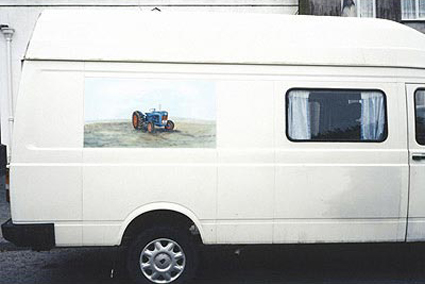
Tractor Painting on Van, Delabole, Cornwall © 2002
The show was conceived out of love for popular art and abhorrence for the meaninglessness of the Millennium Dome. The last retrospective of British folk art took place at the Whitechapel in 1951, so they thought it was about time somebody attacked the subject. Kane and Deller considering the exhibits so unique, priceless or charged by their owners and locations as to be impractical and undesirable to keep together when not on show. (It was first exhibited at The Barbican in 2005).
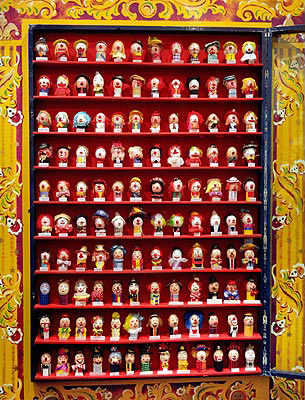
Clown Register, Clowns Gallery, Dalston, London © 2005
The Folk Archive raises absorbing questions about British-ness. How do the strange events and visual ephemera of modern life create an image of a country’s psyche? What are the stories floating behind the glimpses of protest, anger, chaos and fun? Most importantly, how do these objects and images explain the motivation behind creativity? In fact, what makes this collection of photographs, videos and weird stuff so interesting is wondering why they exist at all.
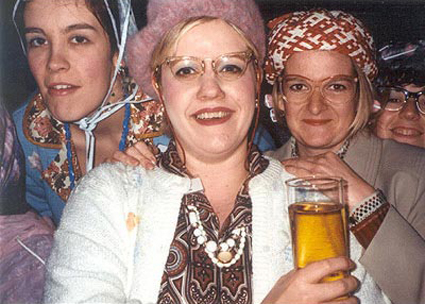
Young Girls dressed as Old Ladies, Blackpool, © 2000
You can see a gallery of more Folk Archive images here and there’s a review in Frieze here.
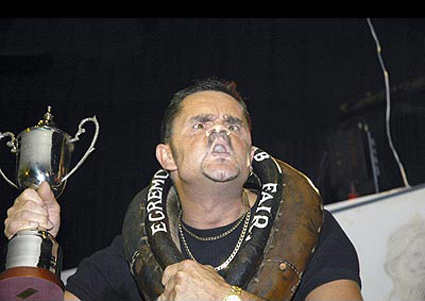
Tommy Mattinson, World Gurning Champion, Egremont, Cumbria © 2004
You can listen to Deller in conversation with Guardian columnist and broadcaster, Jeremy Hardy (2004) here.
And listen to Deller talking at the Royal Society of Arts (2008) here.
Deller’s public event Procession will make its way along Deansgate in central Manchester at 2pm on Sunday 5 July 2009. Commissioned and produced by Manchester International Festival and Cornerhouse.
Start time – 2pm prompt and will last approximately 60 minutes.
Route – Procession will start from the Castlefield end of Deansgate and will end at Manchester Cathedral. Click here to view a map of the route.
Find out more here.
Posted in INSPIRATION, OTHER STUDIES | Comments Off on JEREMY DELLER, THE FOLK ARCHIVE
I was amused (or should that be bemused) to find that Amazon is already listing We English for sale on their website, despite it not shipping until September, and with a 37% discount! How do they do that?
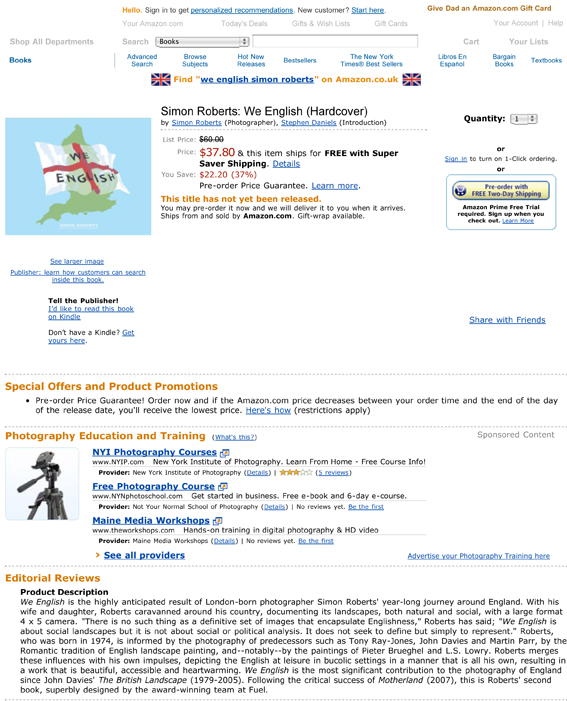
Posted in MISCELLANEOUS | 2 Comments »
Chris and I checked another round of proofs today sent by the printers. We’re now all set to gone on press w/c 28th June.
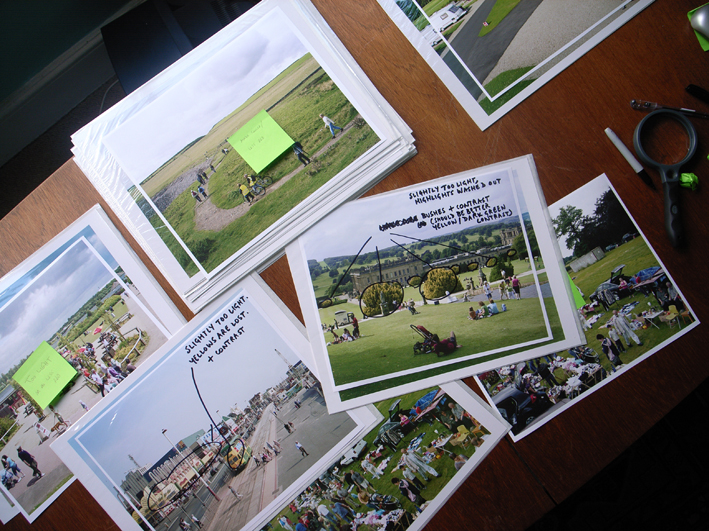
Posted in POST PRODUCTION | Comments Off on FINAL PROOFS
I’ve just received details of a book launch for Tim Brennan’s English Anxieties, details of which are posted below.
John Hansard Gallery, Southampton, 7 July – 29 August 2009
Private View and Book Launch
Monday 6 July 2009, 6.00-7.30pm
Free / All welcome

Tim Brennan’s latest work, English Anxieties, is the result of a commission by Photoworks and Ffotogallery, Cardiff, in association with the European Centre for Photographic Research at the University of Wales, Newport about the Mass Observation Archive (MO) at the University of Sussex. For the last year Brennan has sifted through a myriad of archive boxes and folders, consisting of handwritten and typed reports, drawings and printed ephemera, originally gathered to provide some insight into the social worlds that Mass Observation attempted to analyse from its inception in 1937.
You can read more details here.
English Anxieties features an introduction by Russell Roberts and essays by Andrew Biswell and Peter Davidson. It’s priced at £14.99 and can be ordered on 01273 607 523.
Posted in OTHER STUDIES | Comments Off on ENGLISH ANXIETIES
A friend of mine has just emailed me details of a new project called What is England?, which is the brainchild of UK-based photographer and curator Stuart Pilkington. He’s looking for 46 photographers to participate in the project and here’s the notice that he’s posted on his website if you think you might want to get involved-

Pilkington has launched a number of previous collaborative endeavours with photographers, one of which is currently in full swing. The 50 States Project has brought together 50 photographers from across the USA. Each photographer lives in one of the 50 States and every two months during the course of the year each photographer is sent an assignment by e-mail, they then have two months to produce one image in response. The photographs must represent both their style and their State. He’s got some good photographers involved, including Julianna Beasley (New Jersey), Ben Huff (Alaska) and William Greiner (Louisiana).
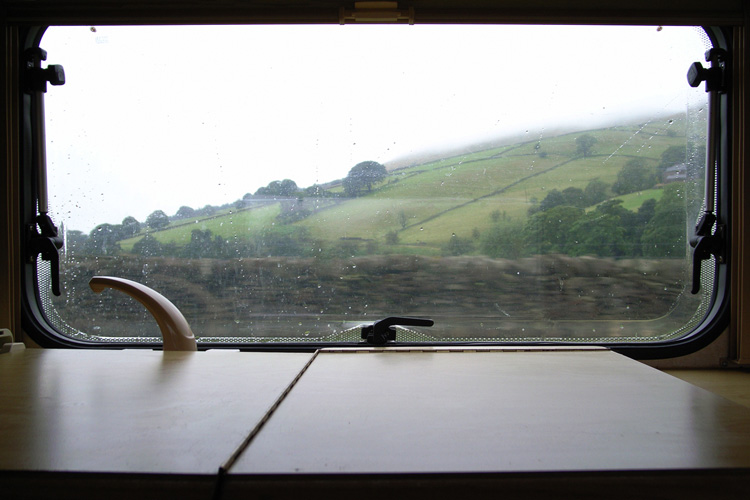
‘Kitchen’ © Poppy Berry, 2008
He also came up with the Alphabet Project, which involved 26 photographers from around the world each of whom had a first name that begins with an unique letter of the alphabet.One of my close friends was involved, Poppy Berry, and I’ve just noticed that one of the photographs she posted for assignment ‘k’ was taken in my Talbot Swift motorhome during the England trip last summer! (Poppy and her husband joined us in the Peak District for a wet weekend break).
Posted in OTHER STUDIES | Comments Off on WHAT IS ENGLAND?
“A riotous journey through four waves of immigration from the 17th century to today. As the French Huguenots, the Irish, the Jews and the Bangladeshis in turn enter the chaotic world of Bethnal Green, each new influx provokes a surge of violent protest over housing, jobs, religion and culture. And the emerging pattern shows that white flight and anxiety over integration is anything but new.”
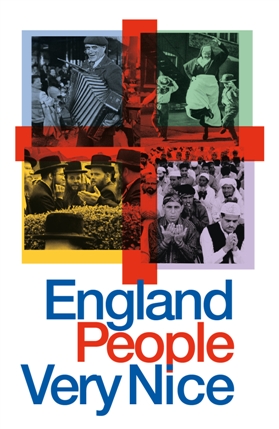
England People Very Nice is a new play by Richard Bean currently on show at the National Theatre in London, which appears to be getting some good reviews-
‘A giddily enjoyable evening…what could matter more than a play which makes audiences look at themselves, which provokes people, through laughter, into feeling uneasy as they laugh.’
Observer
‘A seriously hilarious play, a provocative, swaggering, humane, edgy comedy of immigration, integration and disintegration…Unmissable.’
The Sunday Times
‘Who would think that unsexy subject, waves of immigration into Bethnal Green, could generate as much enjoyable ebullience as it does in Richard Bean’s new play?’
The Times
‘Wise, brave and true…an exuberant production that fills the Olivier stage with seething life.’
The Daily Telegraph
‘A very funny but outrageous comedy…makes you laugh and then wonder whether you should have.’
Financial Times
Posted in MISCELLANEOUS | Comments Off on ENGLAND PEOPLE VERY NICE
I’ve just come across an intriguing project called Darkvan. It was set up by Dominic de Vere and Sebastian Edge who met while doing an MA at the University for the Creative Arts, Maidstone. They have recreated the Wet Collodion process, the first publicly available photographic process, taking it out of laboratory conditions and onto the road by customising a two-berth Ford Transit van featuring a hermetically sealed darkroom.
The Wet Collodion process is a nineteenth century photographic development created by Englishman Frederick Scott Archer that utilities a silver chloride solution bonded to glass to create a black and white negative after exposure in the camera.
Edge and de Vere traveled around Southern England between August 2008 and April 2009 in the Darkvan along with a self built 20×24 inch plate negative camera, which stands 5 feet high and sits 3 feet wide, taking 18 x 22′ glass plates for Collodion exposure.
Here are a few of their results-
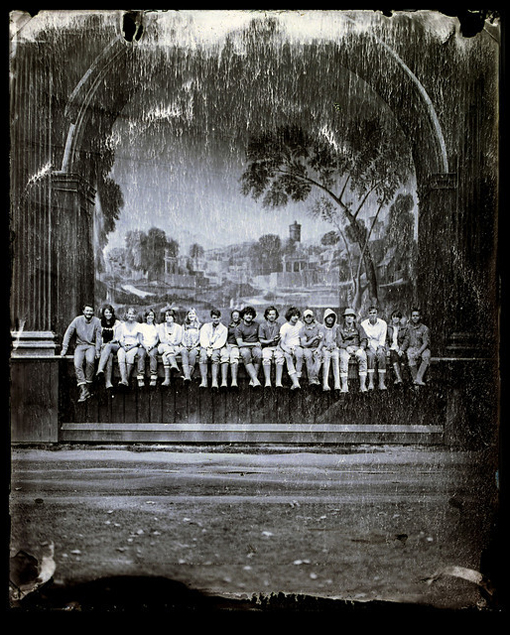
© Dominic de Vere and Sebastian Edge
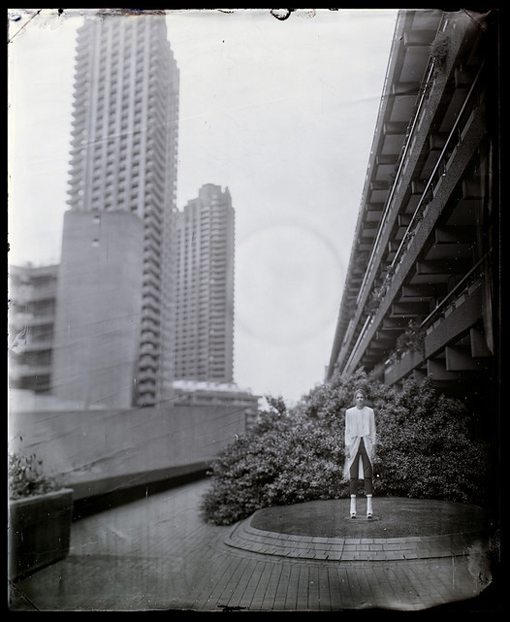
© Dominic de Vere and Sebastian Edge
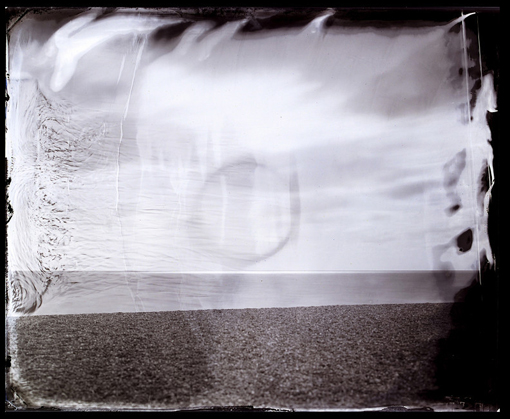
© Dominic de Vere and Sebastian Edge
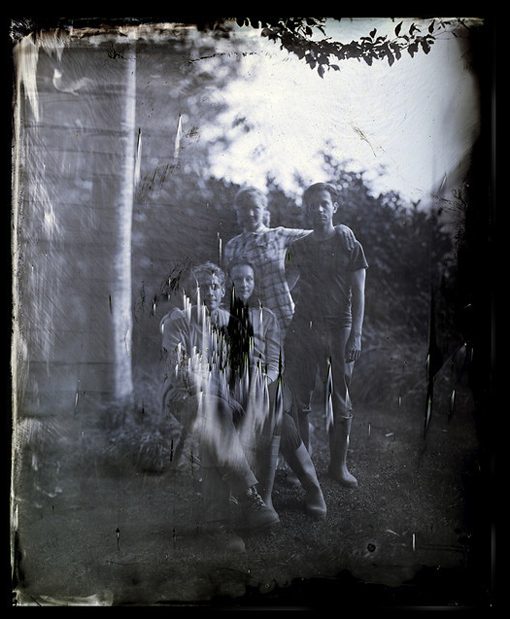
© Dominic de Vere and Sebastian Edge
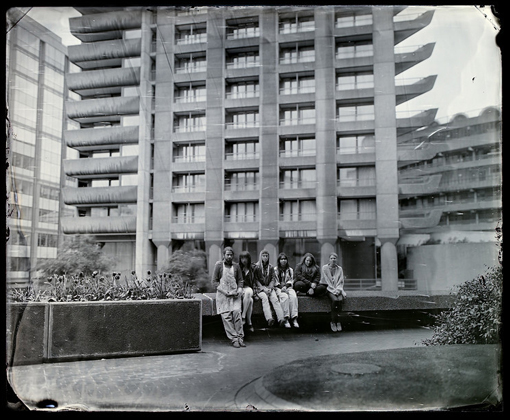
© Dominic de Vere and Sebastian Edge
You can see a wider portfolio of Edge and de Vere’s images here.
You can also watch a video about the Wet Collodion process on the J. Paul Getty website here.
Finally, you can read about the project Surface Stations which formed part of their final show, combining the English weather forecaster, farmer Lester (who is utilised by the Met Office) here. It is a site specific time-lapse work with a mercury cube and Stevenson screens.
Contact Sebastian Edge- sebedge@googlemail.com.
Posted in OTHER STUDIES | Comments Off on THE DARKVAN
We English will be signed off this week and I’ll be heading to Verona at the end of the month to oversee the printing, along with the publisher Chris Boot. As I’ve mentioned before, the book is being designed by Damon Murray and Stephen Sorrell at Fuel, who we worked with on Motherland. Here’s a sneak preview of their fantastic design for the cover:
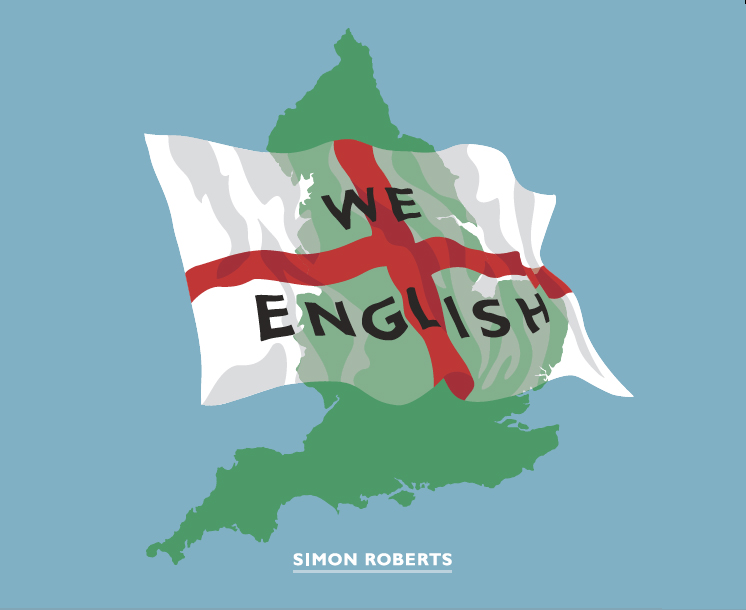
Posted in POST PRODUCTION | 7 Comments »



























































